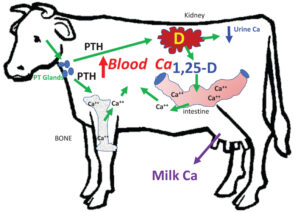
Hypocalcemia, or “milk fever” as it is commonly called, is the result of low blood calcium (Ca). Severe milk fever impairs muscle and nerve function to such a degree that the cow is unable to rise. Hypocalcemia also increases the chances of cows experiencing other disorders such as retained placentas, metritis, mastitis, displaced abomasum, and ketosis.

Figure 1.
A cow’s normal system for keeping blood calcium in the ideal range involves the parathyroid gland in regulating the calcium concentration in the blood. When blood calcium lowers, the parathyroid gland rapidly produces parathyroid hormone (PTH). The PTH then goes to the bone and activates the osteoclast to release bone calcium into the blood, and the PTH also causes the kidney to reduce the excretion of calcium in urine and activates Vitamin D to Vitamin D3, which can then go to the intestines and facilitate increased absorption of calcium from the digestive tract.
The cow’s normal system can be overwhelmed after freshening due to the sudden calcium drain by the mammary gland for milk production. This is especially true for older cows. Jersey cattle tend to be more susceptible to milk fever than Holstein cattle. Blood pH affects tissue responsiveness to PTH. Blood pH is dependent on Diet Cation-Anion Difference (DCAD). The DCAD is affected by the cations sodium (Na) and potassium (K) — which increase blood pH — and the anions chloride (Cl) and sulfur (S), which decrease blood pH. With this in mind, there are steps we can take to help cows avoid hypocalcemia.
Avoid very high potassium forage for pre-fresh cow diets. Forages from fields that have not had manure application recently or potash fertilizer tend to have lower potassium levels. Warm-season grasses such as corn or sorghum accumulate less potassium than cool-season grasses. More mature forages tend to have lower potassium (wheat straw). This does not mean that legume forages (alfalfa and clovers) cannot be used in pre-fresh diets, just that overall potassium levels in the diet need to be moderate (1.0-1.5 %).

Figure 2.
Add anions (chloride or sulfate), without cations, to the pre-fresh diet to lower the DCAD (calcium chloride, calcium sulfate, magnesium sulfate, commercial anion sources). DCAD = (Na+K)-(Cl +S)

Figure 3.
Make sure to have adequate magnesium in the diet in both the pre-fresh and post-fresh diets (about 0.4%) for activation of the PTH-sensitive enzymes (Figure 3).
A potential alternative to low DCAD diets is to feed a low calcium diet to activate the parathyroid gland to produce PTH. It is very difficult to get a diet low enough in calcium to accomplish this with common ingredients used in dairy diets. However, the feeding of Zeolite may make it realistic to achieve. Zeolite binds calcium in the diet, making it unavailable for absorption in the digestive tract and can therefore create a calcium-deficient situation, resulting in PTH release.
A study by Thilsing-Hansen et al. (2001) showed that 10 grams of sodium aluminosilicate (Zeolite A) can bind one gram of calcium in a test tube. The Zeolite also seems to bind phosphate and magnesium, as well. A study (Kerwin et al., 2019) did demonstrate feeding about one pound of Zeolite was successful in avoiding hypocalcemia in a diet with 0.65% calcium, 0.39% phosphorous, 0.42% magnesium and a DCAD of +268 mEq/kg.
In summary, hypocalcemia is a serious metabolic disorder with negative effects on fresh dairy cows. Agri-King has multiple proven ways with both clinical research and practical on-farm experience to deal with this issue. The time has come for all dairy farms to choose a plan to implement and start eliminating milk fever from their herd. AK